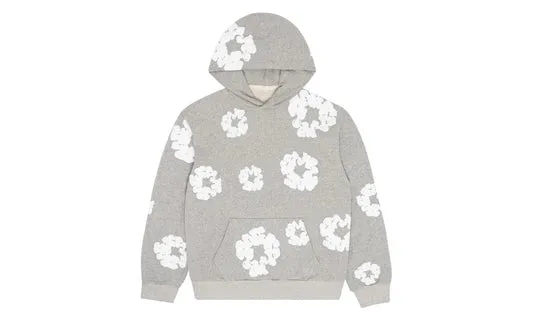Denim Tears was founded by Tremaine Emory, a visionary designer who sought to merge storytelling, activism, and fashion into a single creative expression. Emerging from a deep connection to African American history, Denim Tears Emory used the brand as a means of reclaiming identity through the medium of cotton—a fabric with both beauty and painful historical weight. Denim Tears is more than a fashion label; it is a dialogue between the past and present, bringing awareness to the intertwined legacy of slavery, cotton production, and Black resilience through wearable art and emotional craftsmanship.
The Symbolism of Cotton in Black History
Cotton stands as one of the most loaded materials in American history, representing both the suffering and survival of enslaved Africans. Denim Tears uses cotton intentionally to reclaim its narrative, turning a symbol of oppression into one of empowerment and cultural pride. Through this reclamation, Emory emphasizes that Black people’s contributions to the cotton industry shaped America’s economic foundation. By reimagining cotton as a medium of artistry, Denim Tears honors the ancestors who endured forced labor while celebrating their strength, endurance, and creativity in the face of systemic exploitation.
Merging Fashion and Storytelling
At its core, Denim Tears tells stories through design. Every collection communicates aspects of the Black experience, weaving history into fashion’s fabric. The pieces often feature powerful symbols such as cotton wreaths, African prints, and historical references that connect wearers to a collective narrative. This storytelling approach transforms clothing into conversation, reminding society of fashion’s ability to express identity and social consciousness. Emory’s vision transcends trends, encouraging reflection on heritage, race, and resistance while using garments as a platform to discuss issues too often overlooked in mainstream fashion.
The Influence of Tremaine Emory’s Vision
Tremaine Emory’s creative direction infuses Denim Tears with intellect and emotion, bridging art, culture, and politics. His experiences working with major brands like Supreme and Off-White provided him the industry insight to build a label rooted in authenticity. Emory’s leadership reflects his belief that clothing can provoke thought, heal wounds, and unite communities. Through Denim Tears, he redefines the role of a designer—not as a stylist detached from meaning, but as an educator and cultural storyteller shaping a more conscious future for fashion and identity representation.
Collaboration as a Form of Cultural Dialogue
Denim Tears often collaborates with influential brands such as Levi’s, Converse, and Stüssy to expand its message. These collaborations fuse heritage with innovation, creating pieces that embody shared cultural narratives. By partnering with globally recognized labels, Denim Tears introduces its storytelling to a broader audience, transforming commercial projects into educational opportunities. Each collaboration carries symbolic weight, blending historical reflection with contemporary aesthetics. Through these partnerships, Emory ensures that conversations about race, history, and identity are not confined to niche audiences but resonate across global fashion communities.
Fashion as a Tool for Healing
For many, Denim Tears represents more than fashion—it serves as a form of healing and empowerment. The brand encourages wearers to embrace their roots and confront uncomfortable histories without shame. Emory’s thoughtful use of cotton redefines trauma into triumph, offering beauty where there was once pain. By wearing Denim Tears, individuals participate in a shared act of remembrance and pride. The label’s approach transforms the consumer experience into a spiritual one, where fashion functions as both reflection and restoration for generations affected by historical injustices.
The Role of Art in Social Awareness
Denim Tears exemplifies how art can raise awareness and drive cultural dialogue. Emory’s collections are curated with museum-like intentionality, often sparking debate about the representation of Black identity in modern culture. His art extends beyond fabric—it’s a vehicle for protest and understanding. Through the visual language of fashion, Denim Tears educates audiences about forgotten histories, encouraging them to question narratives long dominated by Western perspectives. In doing so, it challenges the boundaries between art and activism, proving that creativity can inspire societal transformation and empathy.
Sustainability and Ethical Craftsmanship
Beyond its cultural significance, Denim Tears also reflects a commitment to sustainability and ethical creation. Each garment is crafted with care, ensuring that production aligns with the brand’s moral values. Emory emphasizes quality over quantity, reinforcing the importance of conscious consumption in a world obsessed with fast fashion. The careful use of natural cotton and collaboration with responsible manufacturers exemplify the brand’s respect for both people and the planet. Through its practices, Denim Tears champions the idea that true artistry involves care—for materials, history, and humanity.
Community and Representation in Streetwear
Denim Tears has become a cornerstone of inclusive streetwear, offering representation to communities often marginalized within fashion. By blending historical awareness with contemporary style, Emory bridges the gap between luxury and grassroots culture. The brand resonates deeply with young creatives, activists, and thinkers who see fashion as a tool for identity affirmation. Its growing community extends globally, reflecting a universal desire for authenticity and purpose in self-expression. Denim Tears’ designs remind wearers that fashion can be both personal and political, celebrating individuality while fostering collective unity.
The Lasting Legacy of Denim Tears
Denim Tears continues to shape the cultural landscape by fusing activism, artistry, and authenticity. Tremaine Emory’s commitment to storytelling through Denim Tears Hoodie cotton ensures that history remains visible, not hidden. The brand’s enduring influence lies in its ability to connect past struggles with present identities, empowering future generations to embrace their heritage with pride. Through each collection, Denim Tears redefines what fashion can achieve—it becomes a movement of care, consciousness, and creativity. In crafting identity through cotton, Denim Tears weaves threads of remembrance, resilience, and revolutionary love.









